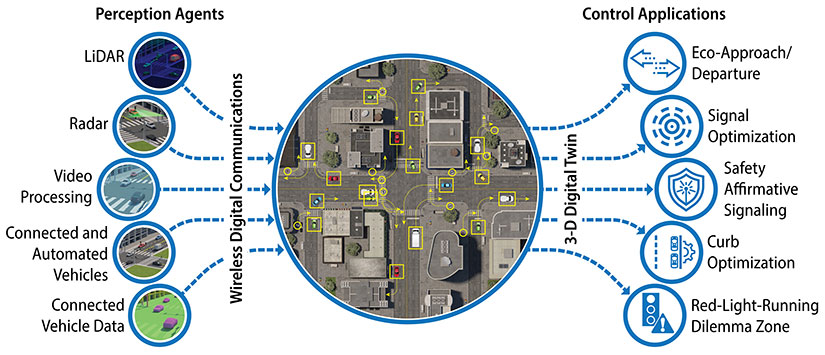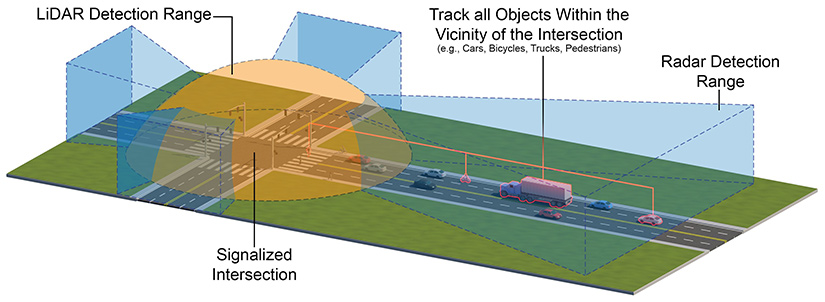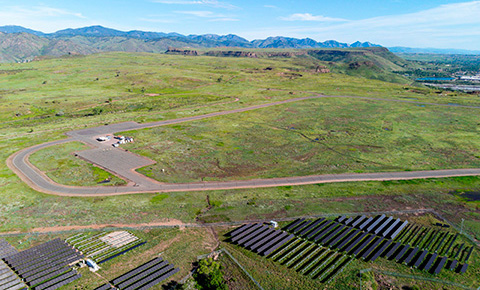New Infrastructure Perception and Control Lab Merges Transportation and Computational Science
NREL Inaugurates New Lab, Advancing Pioneering Research Efforts Into the Real World To Improve Mobility Efficiency and Equity
Billions of devices around the world are connected to the internet, leading to greater connectivity, data processing, and analytics. This "Internet of Things" helps people and organizations automate processes, reduce labor costs, and ultimately live and work smarter.
To explore how the concept can be applied to optimize and modernize legacy transportation systems, the National Renewable Energy Laboratory (NREL) is establishing a lab exclusively dedicated to researching the application of the Internet of Things on the roadside and in the built environment. NREL's new Infrastructure Perception and Control (IPC) Lab builds on the evolving role that advanced sensing and computational controls play in connected and automated movement and applies it to the coordinated movement of vehicles on the road, as well as how people move and navigate in large facilities such as airports.

"The roadway needs to be as intelligent as the cars that drive on it," said NREL's Stanley Young, an advanced transportation and urban scientist who was instrumental in establishing the new lab. "The IPC Lab will further our application of advanced sensing and control technologies to coordinate movement—on the road and within large facilities—while conserving energy, increasing safety, bolstering equity, and reducing travel time for mobility across various realms."
An initial IPC project launched in 2020 inspired the idea for the new lab, as researchers explored the critical role that such perception capabilities can play in advanced traffic control at intersections. In partnership with the city of Colorado Springs, NREL developed an IPC computational engine that uses real-time data from infrastructure-based sensors—such as radar and cameras—to create accurate digital representations of intersection traffic, including vehicles, bicycles, and pedestrians. This approach enables traffic-signal optimization and subsequent energy-efficiency benefits while increasing safety and overall system efficiency.

Outfitting the Lab
The lab will host essential equipment as well as state-of-the-art visualization capabilities, modeling tools, and research expertise to further support NREL's pioneering IPC research. NREL is outfitting the lab with modern equipment—including traffic control cabinets, radar, lidar (light detection and ranging), and video imaging equipment—that can be configured to take on the road as researchers work with partners across the country.
"The IPC Lab will allow us to apply NREL's world-class advanced computing capabilities and IPC domain expertise in ways that elicit real change to roadways across the nation as well as in other nontraditional applications, such as exploring the use of automated mobility platforms to transport people around large facilities," said Qichao Wang, an NREL computational scientist who directs the new lab.
From Device Development to On-Road Evaluation, and Everything in Between
The IPC Lab comprises three tiers enabling evaluation and development at progressive stages.
Tier One: Indoor lab space for concept exploration, development, and prototyping. World-class modeling and simulation capabilities can integrate with devices to create a hybrid virtual-reality experimental facility.

Tier Two: Closed test track and partner-specified protected roadways to provide safe vehicle- and infrastructure-in-the-loop evaluation environments.
Tier Three: Public roads with advanced sensors, selected via established collaborations with partnering cities.
Connecting the Tiers: The indoor lab space (tier one) will bridge to the test roads (tiers two and three) via digital-twin technologies featuring high-fidelity modeling; high-performance computing, simulations, and visualizations; large-volume data streaming and processing; and advanced controls and optimization techniques.
IPC Partnerships: Now and in the Future
In addition to its ongoing IPC project with the city of Colorado Springs, NREL has numerous other IPC projects in the works.
Building on its long-standing partnership with Dallas Fort Worth International Airport to improve mobility energy efficiency, NREL plans to pilot a low-speed, automated valet demonstration project with a focus on its impact on the travel time and equality of employee commutes. The new curbside valet service will showcase an emerging technology enabling employees to save time by dropping themselves off in an employee parking lot in a central location, while the car self-parks and they catch a shuttle to their work location. On their return trip, employees can summon the car to meet them at the curb.
"Creating more equitable mobility, while concentrating first on improving access for those who experience challenges related to reduced mobility, is a guiding principle for all involved," said Andy Duvall, an NREL transportation behavior analyst whose work in the IPC arena focuses on human behavior and the appropriate application of technology to meet societal needs. "Improving mobility for the most vulnerable groups ultimately improves mobility for everyone."
The new lab will enable NREL to create enhanced opportunities, informed by stakeholder and partner input, to explore and grow this body of work. NREL's ongoing IPC collaborations involve numerous universities, a leading traffic control manufacturer, and various sensor manufacturers.
The following examples highlight the breadth of work enabled by the lab's new capabilities:
- Longitudinal light signals—think Christmas lights along lane lines, color coordinated and orchestrated to encourage drivers to self-organize and platoon to increase traffic and signal-timing efficiency
- Advanced wayfinding and local positioning for navigating within large facilities, particularly as it impacts passengers who may need mobility assistance with moving around airports, for example
- Automated valet service integrated with automated electric charging to boost system-level efficiencies
- Development of new tools and methods to better observe and understand human behavior and the adoption of emerging mobility technologies, particularly for underserved communities. As an example, discussions are underway regarding the integration of assistive vehicles like electric wheelchairs in the connected, smart roadway to enhance safety and equity.
Where We Are Heading
The new IPC Lab is part of NREL's Mobility Infrastructure and Information Interdisciplinary Integration Initiative (MI5), led by Young. As part of MI5, NREL plans to launch additional labs to fully complement the future of mobility—with an emphasis on expanding NREL's studies in areas such as micromobility, moving people in large facilities, airport systems, and freight systems.
Contact NREL's Qichao Wang at Qichao.Wang@nrel.gov if you would like to explore IPC partnership opportunities.
Learn more about NREL's sustainable transportation and mobility research. And sign up for NREL's quarterly transportation and mobility research newsletter, Sustainable Mobility Matters, to stay current on the latest news.
